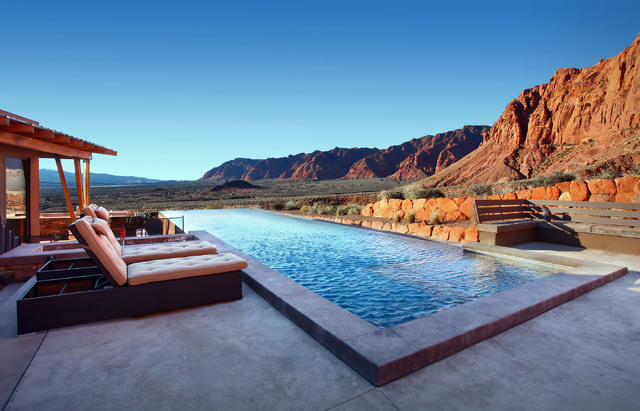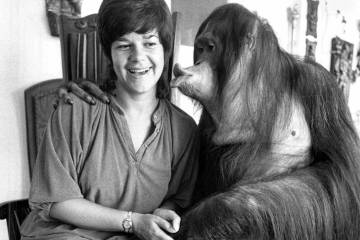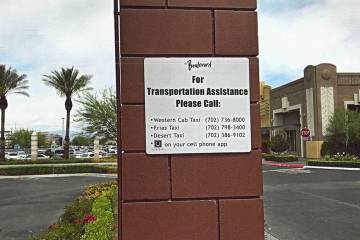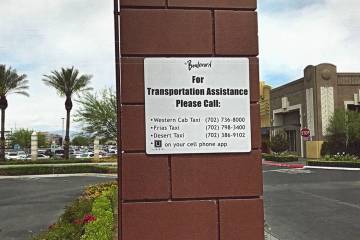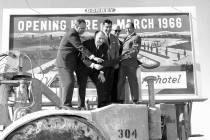Kayenta looks like Red Rock with homes
If you have heard of a unique community 8 miles west of St. George called Kayenta, raise your hand. No? I thought so. Las Vegans keep giving me blank looks when I bring up Kayenta.
Don’t confuse this Kayenta with Arizona’s Kayenta in the Navajo Reservation.
Utah’s Kayenta is a bona fide hidden gem, a development of flat-roofed pueblo-styled homes snuggled at the foot of red cliffs. One view faces red cliffs and the other direction features a peaceful valley. No matter which way you look, the colors evolve depending on the angle of the sun. During strong rains, water cascades off the surrounding mesas, creating spectacular waterfalls.
The equivalent in Las Vegas would be if homes were built inside the Red Rock Canyon National Conservation Area adjacent to the red cliffs. Of course, while I’d fight that, I admired the 400 homes now in Kayenta currently sprawled over 1,000 acres.
California developer Terry Marten and a few partners bought a 1,300-acre ranch in 1975 with an idea.
Marten developed a concept of a community where the desert would be left as desert with low-slung homes designed for spectacular views and privacy. The homes were designed to blend into the landscape. From a distance, the homes almost look like stretches of volcanic rocks dotting the landscape.
“We control about 2,200 acres now,” said Matt Marten, Terry’s 49-year-old son, the main designer in the community and vice president of Kayenta Development Inc. “We’re going to be developing over decades.”
Eventually, he envisions assisted-care facilities and grocery stores, and they all will be designed in the established style with muted colors.
In the first phase, which started in 1982, the homes are closer together and sit higher. In the current phase closer to the cliffs, the lots are larger, 1 acre or more, and most homes are designed to stay low, providing a sense solitude and serenity, peace and quiet.
Marten said his father, now 71, was “trying to bring a different aesthetic and different mind-set, more California indoor/outdoor living like what is popular in Las Vegas, Palm Springs and Phoenix.”
His father’s idea was to use the natural environment so people could live within a natural setting. There’s no grass, and all desert landscaping. Some of it is natural, some of it is not. And the residents live with jackrabbits, cottontails and coyotes, as well as snakes, reptiles and scorpions. Roadrunners abound along with quail, eagles, sparrows and birds of prey. Then there’s the birds just passing through during migration.
Matt Marten said the development didn’t meet with a lot of opposition. “The locals were kind of perplexed; we were dealing with Southern Utah farmers and ranchers, and they didn’t value this land because of the washes, gullies and gorges. They valued flat land.”
Ivins, the tiny town Kayenta claims as a mailing address, has grown along with Kayenta.
“We have good relationships with Ivins. They’ve learned to appreciate what we’ve done over three decades,” he said.
The one model home open had views in all directions. Since it was daytime, I didn’t realize how the designs included low lighting so that people can look at the sky without the distraction of bright lights.
The cost for a lot and a home range from $350,000 to $2 million. Since I don’t play the lottery, there’s no hope I’d ever live there. But as a card-carrying lookieloo, I enjoyed checking it out.
There’s a small art village called Coyote Gulch Art Village with upscale galleries, a pottery studio, the Xetava Gardens Cafe, a spa, a small inn with eight rooms and the real estate office.
Fall and winter would be the perfect time to visit. Although you would lose some of the quiet, the 14th Annual Art in Kayenta Festival is Oct. 11-13.
Kayenta is easy to find. Go up Interstate 15 north to St. George, follow the signs to Ivins and stay on U.S. Highway 91 and there’s Kayenta. The drive up is about 135 miles and two hours long.
Coming back, take old Highway 91 to Littlefield, Ariz., then jump back on I-15. It’s a little longer, 160 miles and about three hours and 15 minutes. You would share the smooth road with bikers and motorcyclists but very few cars, so it’s an easy drive. Much nicer than going 75 mph on the freeway both ways.
Checking out Kayenta to understand the vision of the Martens — father and son — is a great add on to the Utah Shakespeare Festival in Cedar City or the Tuacahn Amphitheater only five minutes away.
As one who couldn’t quite envision Summerlin when it was first proposed, I think I’ll keep an eye on Kayenta, just for fun, to make sure it preserves that treasured serenity.
Jane Ann Morrison’s column appears Monday, Thursday and Saturday. Email her at Jane@reviewjournal.com or call her at 702-383-0275.




